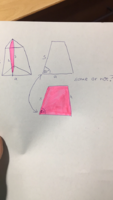Ana.stasia
Junior Member
- Joined
- Sep 28, 2020
- Messages
- 118
I tried looking up how to say this pyramid in English and I found some sources calling it the "a regular fringed pyramid" however I am not sure If this is correct. I drew it so that should be enough, however, please inform me of the correct name.
The question: The angle between the side edge (what I marked as s) and the bottom base's edge (what I marked as a) is 60 degrees. Calculate the top base's edge (what I marked as b) only using bottom base's edge and P (P is the the surface of the pyramid).
This is how I did it:

My solution is very similar to the one from the book. Only where I have 2a2, they have 3a2 and where I have 2P they have 4P. Where did I make a mistake?
Thank you in advance
The question: The angle between the side edge (what I marked as s) and the bottom base's edge (what I marked as a) is 60 degrees. Calculate the top base's edge (what I marked as b) only using bottom base's edge and P (P is the the surface of the pyramid).
This is how I did it:

My solution is very similar to the one from the book. Only where I have 2a2, they have 3a2 and where I have 2P they have 4P. Where did I make a mistake?
Thank you in advance




